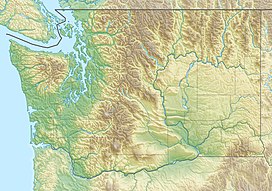| Big Devil Peak | |
|---|---|
 Big Devil Peak from the northeast | |
| Highest point | |
| Elevation | 7,055 ft (2,150 m) [1] |
| Prominence | 1,655 ft (504 m) [1] |
| Isolation | 5.32 mi (8.56 km) [2] |
| Coordinates | 48°36′16″N121°17′37″W / 48.60444°N 121.29361°W [1] |
| Geography | |
 | |
| Interactive map of Big Devil Peak | |
| Country | United States |
| State | Washington |
| County | Skagit |
| Protected area | North Cascades National Park |
| Parent range | North Cascades Cascade Range |
| Topo map | USGS Big Devil Peak |
| Geology | |
| Rock type(s) | Gneiss, Schist |
| Climbing | |
| First ascent | 1963 J. Haggerty, J. Roper [3] |
| Easiest route | Climbing YDS 3 |
Big Devil Peak is a 7,055-foot-elevation (2,150-meter) mountain summit located in North Cascades National Park in Skagit County of Washington state. The peak lies midway between Marblemount and Newhalem and can be seen from the North Cascades Highway at the road pullout for Big Devil Falls. The peak rises 6,600+ feet above the valley floor at this viewing location in the valley. Big Devil is the highest peak of Teebone Ridge, and other peaks on this ridge include Little Devil Peak, Fallen Angel, and The Trapezoid. Precipitation runoff from the mountain drains into tributaries of the Skagit River.




